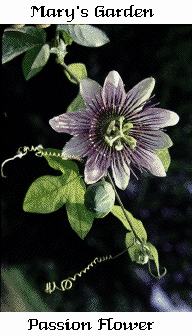John Stokes and Mary's Gardens
The Passion Flower
– John S. Stokes Jr.
The Passion Flower with its various parts is seen as a symbols of Jesus' scourging, crowning with thorns and crucifixion.
This flower, a genus with numerous species, indigenous to the tropical Americas, is unique among the hundreds of old Christian flower symbols in that there is specific historical documentation of the time and place of its origin - the symbolism having been first perceived by the Mexican Augustinian friar, Emmanuel de Villegas, who reported it, with sketches, in Europe in 1610.
It is said that the test of the authenticity of the biblical Prophets was the enduring acceptance of their prophecies by the community. The same can be said of religious flower symbols, whatever their origin: if they achieve enduring acceptance, this signifies, as in the case of the Passion Flower, that they contain a certain "prophetic" unction which enriches the faith and devotion of the believers.
The endurance in religious oral tradition of the "galaxy" of flower symbols of Our Lady, and of her life and her mysteries from medieval times, as discovered and recorded for literate tradition by botanists and folklorists, bears testimony to their enriching prophetic unction, which we at Mary's Gardens propose for wider knowledge and appreciation.

The Passion Flower symbolism, as originally perceived, and then augmented, includes:
- The spiraled tendrils - the lash of Christ's scourging
- The central flower column - the pillar of the Scourging
- The 72 radial filaments - the Crown of Thorns
- The top 3 stigma - the 3 Nails
- The lower 5 anthers - the 5 wounds
- The Style - the Sponge used to moisten Christ's Lips with Vinegar
- The leaves (some species) - the head of the Centurion's Spear
- The red stains - Christ's Blood Drops
- The Round Fruit - The World Christ came to save
- The Fragrance - The Spices prepared by the Holy Women
This multiple symbolism of the Passion Flower combines a number of symbols found in flowers individually in the prior traditions of the rural countrysides of the Old World, from which the missionaries to the New World came.
Thus, in the popular oral religious traditions of Spain, Paliurus aculeatus was known as Espina de Cristo, "Christ's Thorn" (by which name it is generally known today) and Espina Santa, "Holy Thorn"; Pichomon acarna (?) as Azota-Christos, "Christ's Lash"; Gentiana cruciata, Cross Gentian, and others, as Hierba en Cruz, "Herb of the Cross"; Ophioglossum vulgatum, Adder's-Tongue Fern, as Lanza de Cristo, "Christ's Lance"; and Fumaria officinalis, Fumitory, as Sangre de Cristo, "Christ's Blood". Familiarity with these or other plant symbols of the Passion and Cross of Christ no doubt pre-disposed missionaries and their converts to discover symbolism such as that of the Passion Flower, and to make transferrences such as that of the symbolism of "Mary's Gold" from the European Marigold, Calendula, to the golden Tagetes genus of the New World.
Such symbols gave a specific focus of Christian faith to the religious sense of nature, and also provided a visual means of teaching the Gospel story in an era where there were no printed catechisms.
And, once introduced into Europe, the Passion Flower soon acquired other religious names, such as in Germany, Jesus-Leiden, "Jesus' Passion"; Christos-Strauss, "Christ's Bouquet"; Herr- Gotts-Blume, "Our Lord's Flower"; Dorn-Krone, "Crown of Thorns"; Christos-Krone, "Christ's Crown"; Marter, "Martyr"; and Muttergottes-Schurzchen, "Mother-of-God's Star".
Passion flowers, known throughout the world, are grown as greenhouse plants in temperate climates, and often set out in the garden in summer. A marvellous book, Passion Flowers (2nd Edition), by John Vanderplank, MIT Press, Cambridge, USA, 1996, describes 150 of the over 460 known species of Passiflora, with over 120 exquisite color photographs - magnificently documenting the multi-splendored providential celebration of Christ's Passion of this genus. Information on the English National Collection of Passiflora, of which John Vanderplank is curator, and passion flower seeds is available through the Passion Flower Seed Company website.
Copyright Mary's Gardens 1996, 1967
The John Stokes and Mary's Garden collection was transferred to the Marian Library in May 2013. In addition to his archives, manuscripts, artwork, and personal library, John S. Stokes also donated his extensive website. It was transferred to the Marian Library in early 2010. This particular entry is archived content original to Stokes' Mary's Gardens website. It is possible that some text, hyperlinks, etc. are outdated.